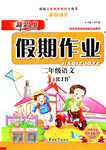题目内容
Scientists are trying to make some small cars that may some day take the place of today’s big cars. If everyone drives such cars in the future, there will be 1_ pollution in the air. There will _2 be more space or parking cars in cities, and the _3_ will be less crowded. Three such cars can fit in__4__ that it is now needed for one car of the usual size.
The little cars will __5___ much less to own and to drive. Driving will be __6___, too, as these little cars can go only 65 kilometers per hour. The little cars of __7___ will be fine or getting out of the city, but they will not be useful for__8__ trips. Little cars which are powered by gasoline( 汽油 ) will go 450 kilometers __9___ needing to stop for more gasoline .
If big cars still are used together with the small ones, _10__ sets of roads will be needed in the future. Some roads will be used for the big, fast cars, and some roads will be needed for the slower, small ones.
The little cars will __5___ much less to own and to drive. Driving will be __6___, too, as these little cars can go only 65 kilometers per hour. The little cars of __7___ will be fine or getting out of the city, but they will not be useful for__8__ trips. Little cars which are powered by gasoline( 汽油 ) will go 450 kilometers __9___ needing to stop for more gasoline .
If big cars still are used together with the small ones, _10__ sets of roads will be needed in the future. Some roads will be used for the big, fast cars, and some roads will be needed for the slower, small ones.
| 小题1: |
|
| 小题2: |
|
| 小题3: |
|
| 小题4: |
|
| 小题5: |
|
| 小题6: |
|
| 小题7: |
|
| 小题8: |
|
| 小题9: |
|
| 小题10: |
|
小题1:B
小题2:B
小题3:B
小题4:D
小题5:C
小题6:B
小题7:D
小题8:B
小题9:C
小题10:B
试题分析:这篇短文中作者主要描述了未来的一种小型汽车的应用,并详细介绍了使用这种汽车的好处。
小题1:结合语境可知此处指的是空气污染就会更少,故选B,更少的。
小题2:联系前一句描述,可知城市中也会多出更多的停车的地方,too一般用于肯定句尾,故选B,也。
小题3:结合语境可知此处指的是大街上就不在那么拥挤,故选B,大街。
小题4:联系下文that it is now needed for one car of the usual size.可知此处指的是停车的空间,故选D,空间。
小题5:动词辨析。take 用于 it takes sb ... to do sth句型,仅指花费时间(three hours等),必须用it作形式主语,指代下文不定式内容;spend用于sb spend...on sth或者sb spend...in doing sth(in可以省略),spend的主语必须是人,可以指花费时间、也可以指花费金钱;cost用于 sth costs sb sth,主语必须是物,多指花费金钱,少数情况可指花费时间、气力,有时表示成本的消耗;pay的基本用法是:(1) pay (sb.) money for sth. 付钱(给某人)买……。 (2)pay for sth. 付……的钱。 (3)pay for sb. 替某人付钱。(4)pay sb. 付钱给某人。结合语境可知这种车会花费更少,故选C。
小题6:联系后一句as these little cars can go only 65 kilometers per hour.描述,可知此处指的是驾驶也会变得更安全,故选B,更安全的。
小题7:结合语境可知此处指的是将来的小汽车,故选D,将来,未来。
小题8:根据后一句描述,可知他们不适合用来长途旅行,故选B,长的。
小题9:连词辨析。A.在……之后;B.那么,然后;C.在……之前;D.当……时。结合语境可知此处指的是在需要停下来加油之前,故选C。
小题10:联系前一句描述,可知此处指的是需要两套公路,故选B,两个。
点评:本题短文内容不难理解,但是部分小题与上下文联系不大,部分题型甚至可以独立成题。因此在解答中有必要认真分析,把他们当成一个独立的选择题来对待。完成后多读几遍,看看上下文是否语句通顺,符合逻辑关系。

练习册系列答案
 学练快车道快乐假期寒假作业系列答案
学练快车道快乐假期寒假作业系列答案 新思维寒假作业系列答案
新思维寒假作业系列答案
相关题目






